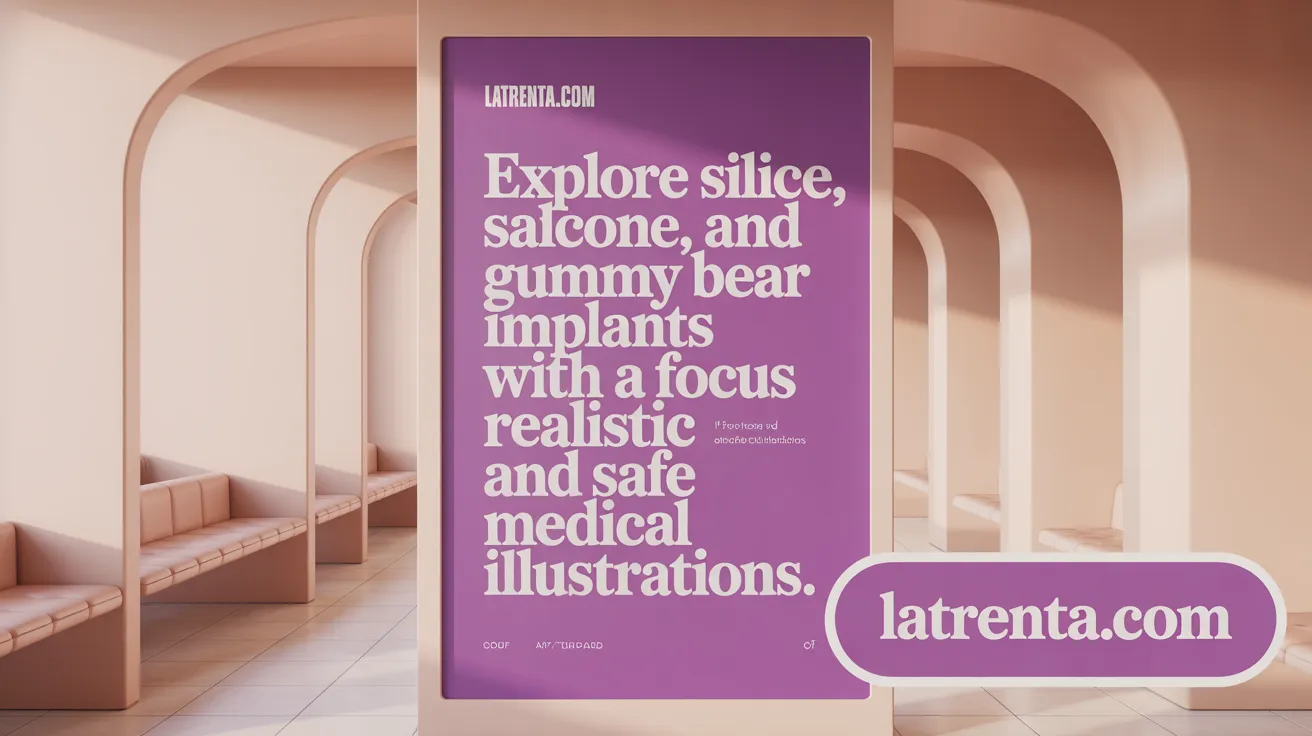Achieving Subtlety and Balance in Breast Augmentation
In today's cosmetic surgery landscape, women increasingly seek breast augmentation options that enhance their natural beauty with subtlety and balance. Rather than dramatic changes, the trend favors personalized procedures tailored to body proportions, lifestyle, and aesthetic goals. This article explores the various breast augmentation options designed to achieve natural, harmonious results, emphasizing innovative techniques, implant types, and alternative methods to implants.
Choosing the Right Implant Type and Material for Natural Results

Silicone vs Saline Implants
Silicone implants are generally preferred for natural-looking breast augmentation because their soft, cohesive gel closely mimics the feel and movement of natural breast tissue. In contrast, saline implants often feel firmer and have a higher tendency to show rippling under the skin, which can compromise a natural appearance. Silicone implants are FDA-approved for women aged 22 and older, while saline implants are approved for women aged 18 and older.
Gummy Bear Implants and Their Benefits
Gummy bear implants are a type of highly cohesive silicone gel implant that maintain their shape even if the shell is compromised. Their firmer gel offers lower rates of capsular contracture complication and reduced rippling compared to traditional silicone and saline implants. These implants provide a more stable, natural contour but may require longer incisions due to their shape and are typically available only in a teardrop (anatomical) form.
Natural Feel and Appearance of Implants
The choice of implant material significantly influences the aesthetic outcome. Silicone and gummy bear implants tend to feel softer and more natural, enhancing the breast’s natural contour and movement. Saline implants, while safe and adjustable, may produce a less natural feel and visible rippling, especially in women with thinner breast tissue.
FDA Approval and Safety Considerations
All breast implant types discussed—silicone, saline, and gummy bear—are FDA-approved with established safety profiles. Regular monitoring, including imaging for silicone implants, is recommended to check for silent ruptures. Gummy bear implants may lower the chance of complications like capsular contracture but come with considerations such as cost and incision length.
Material Impact on Rippling and Rupture Risk
Silicone and gummy bear implants show less rippling due to their cohesive gel content. The gummy bear gel’s form stability also reduces rupture risk, contributing to longevity. Saline implants are more prone to visible rippling and rupture but the saline solution is safely absorbed by the body if leakage occurs.
Choosing the implant type and material should be guided by a board-certified plastic surgeon who can tailor selections based on individual anatomy and desired natural results.
Implant Shapes, Profiles, and Sizes: Crafting a Balanced Silhouette

What implant shapes lead to the most natural results?
Implants come mainly in two shapes: round and teardrop-shaped implants (also called anatomical). Teardrop implants are designed to mimic the natural slope of the breast, providing a more natural contour. They are often made with Gummy bear implants, which helps maintain the shape and offers a soft feel similar to natural tissue. On the other hand, round implants tend to create a fuller, more projected appearance, which may be less natural in some cases but desired by women seeking more upper breast fullness.
How do implant profiles and sizes influence naturalness?
Implant profiles refer to how much the implant projects from the chest relative to its base width. There are low, moderate, and high profiles. Moderate profile implants are generally considered the best for natural outcomes because they provide a balanced projection that complements the breast and body frame without looking exaggerated.
Size selection typically ranges from implant sizes 300cc to 500cc for those aiming for a natural enhancement. Choosing a size that suits the patient’s body frame is essential; implants that are too large for the body can look disproportionate and unnatural, while well-matched sizes create harmony and balance.
Importance of proportion to body frame
No matter the implant shape or profile, proportion to the individual’s body frame is crucial. A small, slender woman will achieve a more natural appearance with smaller or moderate-sized implants and moderate or low-profile shapes. Conversely, larger bodies may accommodate bigger implants while still maintaining a natural look if the width and projection align with their anatomy.
Careful implant selection and Submuscular implant placement customized to the patient's unique anatomy, combined with an experienced surgeon for breast implants aesthetic judgment, play pivotal roles in achieving a balanced and natural breast silhouette.
Implant Placement and Surgical Techniques for Natural Contours

Submuscular vs Subglandular Placement: Which Yields More Natural Results?
Submuscular implant placement involves positioning the implant beneath the pectoral muscle. This technique is often favored for patients with limited natural breast tissue, as it provides a smoother transition from the chest wall to the breast, resulting in a more natural appearance. It also reduces the risk of visible implant edges and rippling. Conversely, subglandular placement situates the implant above the muscle but beneath the breast tissue, making it suitable for those with sufficient natural breast tissue. This placement often allows for a faster recovery, though it may be less natural-looking for those with minimal breast tissue.
Common Surgical Incision Sites and Their Benefits
Surgeons use various incision options tailored to each patient's anatomy and aesthetic goals. The inframammary incision , located in the breast crease, is the most common choice. It offers excellent surgical access and tends to leave the least conspicuous scarring. Peri-areolar incisions circle the nipple area, balancing access with the potential for slightly more visible scars. Trans-axillary incisions through the armpit avoid breast scars altogether but may limit direct visualization during surgery. Transumbilical incisions, via the navel, are less common and typically restrict implant type and size. The chosen incision impacts scar visibility and surgical precision, which in turn influence the naturalness of the final result.
Combining Augmentation with Breast Lift
For patients with sagging breasts or excess skin, combining breast augmentation with a lift procedure can enhance natural contours effectively. A breast lift repositions and reshapes breast tissue and the nipple, allowing implants to sit more naturally within the newly contoured breast envelope. This combination is especially beneficial post-pregnancy or significant weight changes.
The Surgeon’s Role in Personalized Placement Strategy
An experienced, board-certified plastic surgeon plays a crucial role in customizing implant placement to each patient’s unique anatomy and aesthetic preferences. Through detailed consultations, surgeons assess factors such as breast tissue thickness, skin elasticity, chest wall shape, and lifestyle considerations. They then recommend the optimal implant position, size, shape, and incision approach to achieve balanced, natural-looking results.
By carefully selecting implant placement and surgical technique, patients can enjoy a breast augmentation that enhances their physique with natural contours and minimal scarring.
Fat Transfer Breast Augmentation: An Alternative for Natural Enhancement
Procedure Overview and Donor Site Options
Fat transfer breast augmentation is a surgical technique that utilizes liposuction to harvest fat from donor areas such as the abdomen, hips, thighs, back, or arms. The extracted fat is then purified—often using a centrifuge—to prepare it for injection. This purified fat is strategically injected into the breasts to enhance volume and shape. Because it uses the patient's own fatty tissue, this method avoids foreign implants entirely.
Advantages of Using Patient's Own Fat
One major benefit of using fat transfer breast augmentation is the natural feel and appearance it provides. The procedure results in subtle, soft enhancement that closely mimics natural breast tissue without the need for synthetic materials. Additionally, liposuction contours the donor areas, offering a dual benefit of improving both body shape and breast volume with minimal scarring.
Limitations in Volume Increase and Potential Multiple Sessions Required
Fat transfer typically achieves a modest increase in breast volume—usually about one cup size. Due to the body's natural reabsorption of some of the transferred fat (commonly 20-40%), additional sessions may be necessary to reach the desired fullness. Hence, patients should have realistic expectations regarding the gradual enhancement process.
Recovery Process and Risks
Post-procedure, patients can expect bruising, swelling, and discomfort at both donor and recipient sites. Wearing compression garments is recommended to aid healing. Most patients resume work within 3 to 4 days, with more strenuous activities postponed for several weeks to support optimal results. Final outcomes are typically seen within 3 to 6 months. Potential risks include fat necrosis, infection, and formation of benign cysts or calcifications that may require further evaluation.
Ideal Candidates for Fat Transfer Augmentation
The best candidates are in good overall health, nonsmokers, with sufficient fat deposits in donor areas and realistic expectations about volume enhancement. This approach suits those seeking subtle breast augmentation, natural breast augmentation, or who prefer to avoid implants. It is particularly valuable for correcting asymmetry or augmenting volume post-pregnancy or weight fluctuations while also improving donor site contours.
Hybrid Approaches and Addressing Breast Asymmetry for Balanced Results
How can combination techniques enhance natural breast augmentation?
Hybrid breast augmentation merges the use of small breast implants with fat transfer breast augmentation. This combination allows for enhanced volume and more refined breast contouring. Fat transfer adds a softer, more natural feel to the breasts and helps conceal implant edges or rippling that may be visible with implants alone. It offers the benefits of both methods—augmentation with implants for size and structure, along with fat grafting for subtle shape enhancement and improved skin texture.
How are breast asymmetries corrected naturally?
Breast asymmetry, which can vary from mild to significant, is addressed by customizing implant size, shape, and placement for each breast to achieve balance. Surgeons select from round or teardrop-shaped implants and may position implants differently (above or below the muscle) to harmonize breast size and contour. Revision surgeries are available for those with unsatisfactory previous augmentations to correct implant malposition, capsular contracture, or disproportionate sizing. These tailored approaches restore a natural and symmetrical appearance.
What role does personalized surgical planning play?
Personalized surgical planning is essential to match implant selection and technique with the patient's unique anatomy and aesthetic goals. Surgeons evaluate breast tissue quality, body frame, and desired outcome during detailed consultations. This ensures the choice of implant type, size, shape, projection profile, and placement method complements the natural breast silhouette.
What are the benefits of combining breast lifts with augmentation?
Breast lifts (mastopexy) can be combined with augmentation to address sagging while adding volume, especially after pregnancy or weight changes. This combined procedure restores youthful breast shape, enhances contour, and supports implant positioning. The synergy between lifting and volumizing results creates balanced and natural-looking breasts.
The Surgeon’s Expertise and Consultation: Keys to Natural Outcomes
Why is surgeon expertise crucial for natural breast augmentation?
Double board-certified surgeons possess extensive training and experience essential for achieving natural and balanced breast augmentation results. Their expertise allows for a thorough assessment of a patient’s body type, breast anatomy, and aesthetic goals. This ensures the selection of appropriate implant type, size, and placement technique tailored to each individual, which preserves the breast’s natural look and feel.
How do consultations contribute to personalized treatment?
Comprehensive consultations form the foundation of successful breast augmentation outcomes. During these sessions, surgeons engage in detailed discussions about the patient's desired size, shape, and lifestyle, considering factors like activity level and anatomy. Advanced tools such as implant sizers and 3D imaging enable patients to visualize potential outcomes, fostering realistic expectations and informed decision-making.
Matching patient anatomy and lifestyle
Surgeons emphasize aligning the procedure with the patient’s natural proportions and lifestyle. For example, implant placement — whether under the muscle for a more natural contour or over the muscle for faster recovery — is chosen based on factors like existing breast tissue and activity needs. This tailored approach helps achieve results that look harmonious and feel comfortable.
Discussing realistic expectations and risks
Consultations also provide an opportunity to address the potential risks, such as capsular contracture or implant rupture, and the maintenance required over time. Surgeons discuss recovery timelines and possible need for revision surgery, ensuring patients enter the procedure well informed and confident.
Effective breast augmentation hinges not only on the technical surgical skill but also on personalized planning and clear communication to meet individual goals naturally and safely.
Recovery, Safety, and Long-Term Maintenance for Natural Looking Breasts

What does recovery from breast augmentation typically involve?
Recovery from breast augmentation generally includes soreness, swelling, and bruising. Most patients can return to light daily activities within a week, while more strenuous exercises are typically resumed after 2 to 4 weeks. Wearing supportive bras and closely following the surgeon's post-operative care instructions are crucial for optimal healing. For detailed guidance, see Breast augmentation recovery process and Postoperative care for breast augmentation.
What are the potential risks and complications such as capsular contracture?
One of the significant complications is capsular contracture complication, where scar tissue forms tightly around the implant, potentially causing hardness and distortion of breast shape. Other risks include infection, bleeding, implant rupture, asymmetry, and changes in nipple sensation. While rare, textured implants have been associated with a higher risk of breast implant-associated anaplastic large cell lymphoma (BIA-ALCL). More information can be found at Breast implant risks and Breast Implant Safety.
How are implants monitored for long-term safety?
Silicone implants require regular monitoring, typically starting 5 to 6 years after surgery, using imaging techniques such as MRI or ultrasound to detect silent ruptures. Regular follow-up visits allow surgeons to evaluate implant integrity and address complications like capsular contracture or implant displacement. Fat transfer augmentations generally require less intensive monitoring but might need additional sessions for volume touch-ups. Refer to Breast Implant Monitoring and Fat transfer breast augmentation risks.
What is the longevity of different implant types?
Saline implants tend to last around 10 to 15 years, while silicone implants, especially cohesive gel or gummy bear implants, may last longer, often up to 20 years or more. All implants are not lifetime devices, and replacement or removal may be necessary due to rupture, complications, or patient preference. For thorough details, see Types of Breast Implants and Safest breast implant options for 2025.
How do breast implants impact breastfeeding and mammography?
Breast augmentation can affect breastfeeding, largely depending on implant placement and incision type, but many women successfully breastfeed post-surgery. Implants may complicate mammogram imaging; however, specialized techniques enable effective cancer screening without significant interference. Regular screenings and communication with healthcare providers remain essential for long-term breast health. For more information, consult Breast implants and mammogram and Breast augmentation and breastfeeding.
Embracing Natural Beauty Through Personalized Breast Augmentation
Achieving a natural, balanced breast augmentation involves thoughtful consideration of implant type, size, shape, and placement, as well as alternative techniques such as fat transfer. The expertise of double board-certified surgeons and personalized consultations are paramount in crafting results that harmonize with a patient’s unique anatomy and lifestyle. Advances in surgical methods and implant technology continue to improve the safety and natural appearance of breast enhancements. Whether through subtle implants, fat grafting, or combination approaches, today's options empower women to enhance their curves elegantly, confidently, and authentically.
